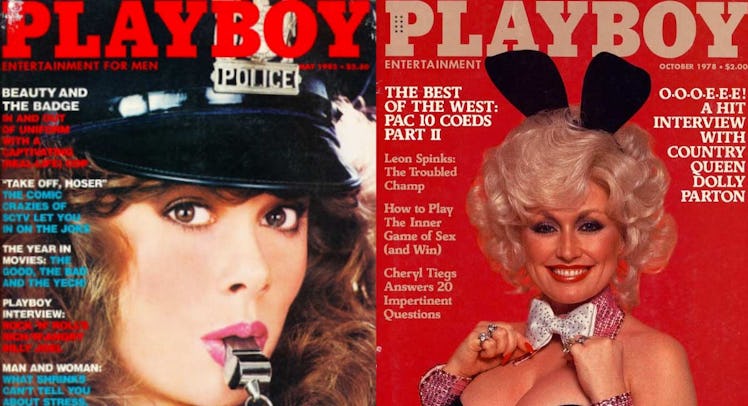Hugh Hefner’s ‘Playboy’ Was a Pretty Good Magazine for Boys
The best use case for Hefner's version of Playboy was furtive and wide-eyed consumption by pre-teen snoops.

Hugh Hefner didn’t make the bunny logo for Playboy out of whole cloth. It was his versioned, mid-century take on a rabbit motif stitched into a childhood blanket he loved. The bunny comforted Hefner and the media empire he built around it comforted both men and boys — mostly boys. That’s both the best thing that can be said about Playboy under Hefner and the most damning. The magazine he created did little to drag its middle-class readers towards the intellectual deep end and a lot to help straight boys wade gently into their sexuality.
That’s not to say that Playboy was a bad magazine. It wasn’t. It was a good magazine. It had great interviews, many of which feature African-American men speaking about their experiences in America, and ran a lot of excellent fiction. But the text isn’t what made the magazine unique. Hefner was famously a huge fan and then employee of Esquire and, in essence, the text of his magazine was a knock-off of that product. Playboy’s literary legacy is not totally insignificant, but it is dwarfed by its sexual legacy. The joke about reading Playboy for the articles contains at least two germs of truth: That’s a thing that a person could do, but that wasn’t the point.
Boys certainly didn’t crack Playboy for the articles. The trope of young men finding copies of their dad’s stash, pantomimed with almost alarming regularity in eighties movies, didn’t come from nowhere. Boys did find their father’s copies of the magazine and, in so doing, became a critical part of Hefner’s audience. Not only that, boys found Playboys and shared them with each other and returned to the stash on multiple occasions. A scene from Bad News Bears drives home the point that Playboy was neither outre enough to unnerve boys or sexy enough not to be consumed socially. The reaction the photos intended to provoke was verbal (“wow”), not liquid.
The thing that made Playboy unique was not images of naked women. It is not hard — and anyone who has been a boy can attest to this — to find or draw images of naked women. It was the nature of those images and those women. The images were sexual, but far from pornographic. The women were clearly posed, comically airbrushed, and removed from anything faintly resembling the real world. Sure, some posed amply in well-appointed kitchens, but there was never a furtive element to the images. The women were made to look like consumer goods. Boys understood how to want them not because of burgeoning sexual urges, but because of a broader familiarity with commerce.
Did these experiences have far-reaching consequences for boys? Some likely did and, yes, Playboy helped teach boys to objectify women. But Playboy wasn’t pornography and Hefner wasn’t a pornographer — though his company did wind up in that business. Hefner was a man who sold sex and, whether it was intentional or not, the publishing side of his business ended up selling sex to kids. There would have been more moral panic about this if people didn’t understand subconsciously or reflexively that Playboy was for kids. The magazine objectified grown women in a manner designed to make them seem approachable to less-grown men. This is why Playboy always seemed more innocent that antecedents like Maxim, which featured images of women looking like they wanted readers to undress.
For those that grew up aware of Playboy, which is to say most men, the bunny logo, rendered ubiquitous by Playboy Enterprise’s reliance on licensing fees, is a nostalgic thing. It doesn’t make men think about sex. It makes men think about how they thought about sex when they were little boys. The fact that these memories, specifically the ones surrounding the centerfolds, tend to be fond is a tribute to Hefner’s highly specific artistry and also broadly indicative of the truth: Playboy magazine was for kids. Maybe that wasn’t true out of the gate, but it became true quickly and stayed true for a long time. The best use case for those magazines was wide-eyed neo-lust.
It doesn’t feel coincidental that a logo derived from Hef’s childhood memories would eventually come to trigger childhood memories in others.
It’s understandable that Playboy unnerved a lot of people back in the ’60s. Today, it doesn’t unnerve anyone (or shouldn’t anyway). Parents could be forgiven for letting issues lay around the house in the hopes it might distract boys from what’s readily available on the internet. Playboy the brand is strong, but Playboy the magazine has struggled in recent years. With Hefner gone, it may well cease to be. If and when that day comes, it will be remembered as one of a large number of publications that couldn’t survive in a modern publishing environment. It likely won’t be remembered, at least not explicitly, as having been a magazine for kids.
But that’s what it became.
Hugh Hefner always seemed to want comfort more than sex. He was different from most grown men that way. He was, in that sense, childlike. He was not, however, innocent.